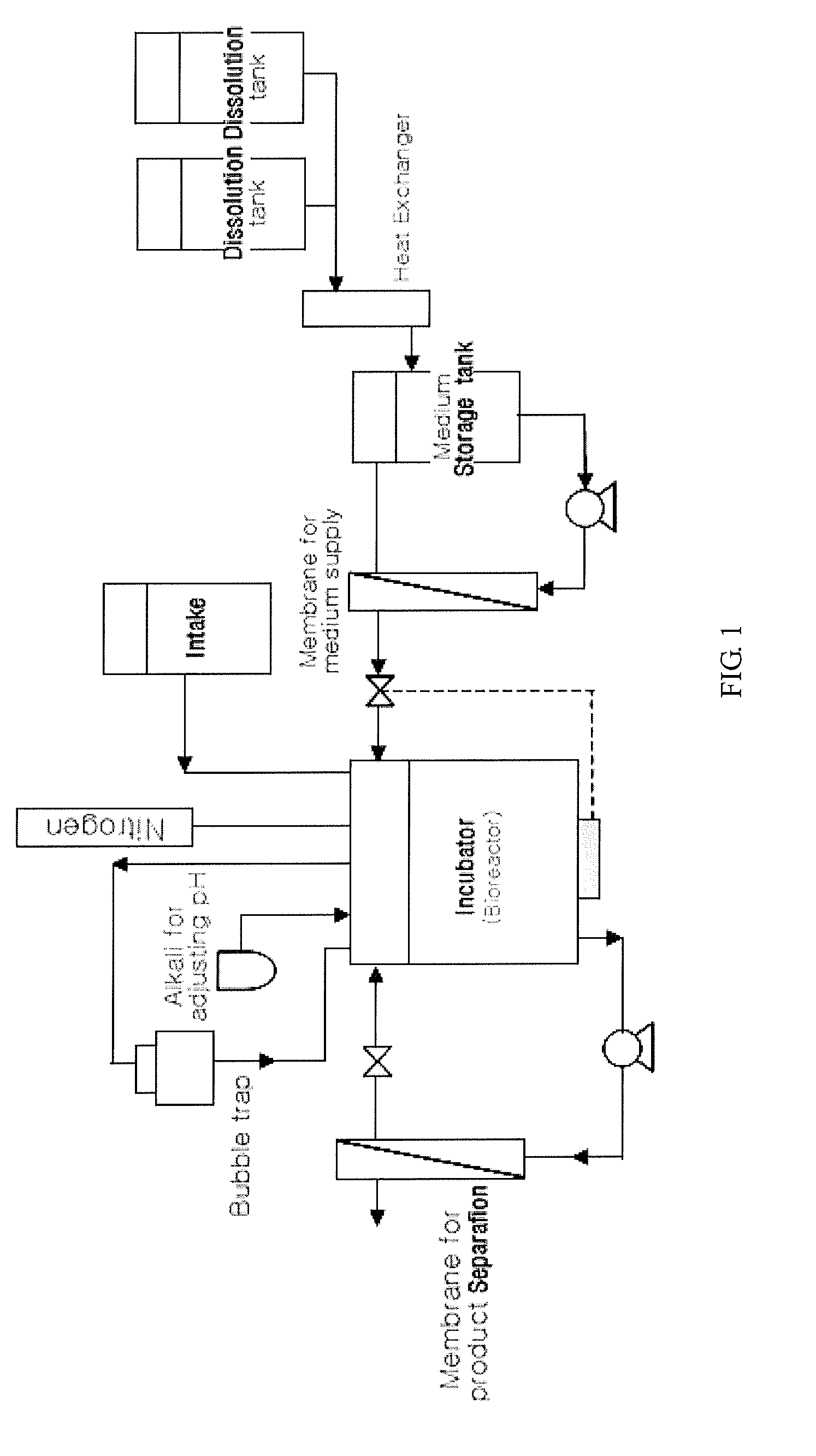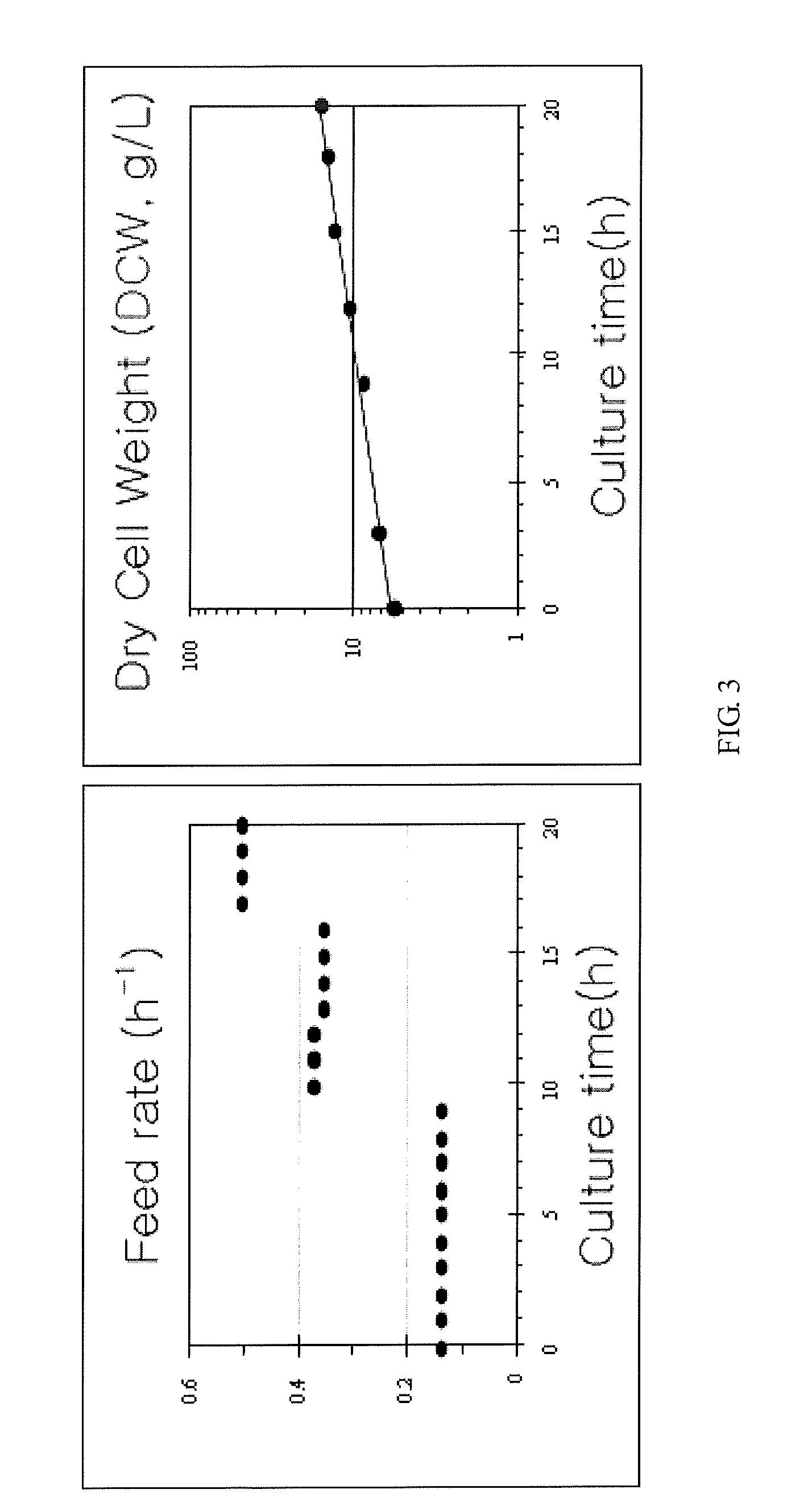Method for producing high concentrate lactic acid bacteria with membrane bioreactor and freeze-dried, lactic acid bacteria powder
- Summary
- Abstract
- Description
- Claims
- Application Information
AI Technical Summary
Benefits of technology
Problems solved by technology
Method used
Image
Examples
experimental example
[0019]Strains, Media and Analysis
[0020]Lactobacillus plantarum (KCTC3928), Lactobacillus rhamnosus (KCTC3929), Bifidobacterium longum (KCTC5084), and Streptococcus lactis (ATCC12929) were tested. BL media (Difco) was used for seed culturing of the Bifidobacterium longum strain and MRS media (Difco) was used for the remaining three strains.
[0021]Cultivation was scaled up from flask culturing to a pH-controlled jar fermenter, and then to culturing in a membrane bioreactor. The compositions of the culture media used in the examples are as below:
TABLE 1Composition of culture media for lactic acid bacteriaStrainsplantarumlongumrhamnosusStreptococcuslactisMediumaqueous solution of aqueous solution ofaqueous solution ofaqueous solution ofcompositionglucose 3%,lactose 2.5%,glucose 3%,glucose 3%,soy peptone 0.5%,soy peptone 1%,soy peptone 0.5%,soy peptone 2%,casein peptone 2%,casein peptone 1%,casein peptone 2%,yeast extract 1.5%,yeast extract 1%,yeast extract 1.5%,yeast extract 1%,dipotassi...
example 1
Culturing in a Membrane Bioreactor
[0031]The lactic acid bacterial strains were cultured in the membrane bioreactor. Feed rate of substrate was increased with the increase of cell concentration.
[0032]As shown in FIG. 2, the Lactobacillus plantarum strain showed DCW of 16.5 g / L at 24 hours. Feed rate of substrate was stepwise increased from 0.047 h−1 to 0.83 h−1 with the increase of cell concentration.
[0033]As shown in FIG. 3, the Lactobacillus rhamnosus strain showed DCW of 15.7 g / L at 20 hours. Feed rate of substrate was stepwise increased from 0.13 h−1 to 0.48 h−1. Feed rate could not be further increased beyond 0.48 h−1 because the by-products caused fouling in the membrane.
[0034]As shown in FIG. 4, the Bifidobacterium longum strain showed DCW of 23.5 g / L at 11 hours. Feed rate of substrate was increased to 0.57 h−1, where no fouling was observed.
[0035]As shown in FIG. 5, the Streptococcus lactis strain showed DCW of 12.9 g / L at 68 hours. Feed rate of substrate was stepwise increa...
example 2
Comparison of Total Cell Concentration and Productivity
[0036]Table 3 provides comparison of total cell concentration and productivity of the Lactobacillus plantarum, Lactobacillus rhamnosus, Bifidobacterium longum and Streptococcus lactis strains, each of which was cultured in three ways, i.e., in a flask, in a stirred tank and in a membrane bioreactor, respectively.
TABLE 3Total cell conc.ProductivityStrains(Δ dry cell weight, g / L) Δ dry cell weight g / L · h−1LactobacillusFlask1.120.021plantarumStirred tank1.830.061Membrane bioreactor16.20.704LactobacillusFlask2.230.086rhamnosusStirred tank2.330.065Membrane bioreactor15.52.018BifidobacteriumFlask3.230.135longumStirred tank4.040.367Membrane bioreactor22.22.018StreptococcuslactisFlask0.910.019Stirred tank0.540.019Membrane bioreactor12.80.188
[0037]For all four strains experimented with, total cell concentration was remarkably improved when the culture was performed in the membrane bioreactor. The Lactobacillus plantarum, Lactobacillus r...
PUM
 Login to View More
Login to View More Abstract
Description
Claims
Application Information
 Login to View More
Login to View More - R&D
- Intellectual Property
- Life Sciences
- Materials
- Tech Scout
- Unparalleled Data Quality
- Higher Quality Content
- 60% Fewer Hallucinations
Browse by: Latest US Patents, China's latest patents, Technical Efficacy Thesaurus, Application Domain, Technology Topic, Popular Technical Reports.
© 2025 PatSnap. All rights reserved.Legal|Privacy policy|Modern Slavery Act Transparency Statement|Sitemap|About US| Contact US: help@patsnap.com



